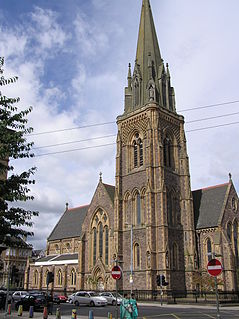
The Cathedral Church of St Mary the Virgin, commonly called St Mary's Cathedral, is a cathedral of the Scottish Episcopal Church. It is located on the Great Western Road, in the west end of Glasgow, Scotland. The current building was opened on 9 November 1871 as St Mary's Episcopal Church and was completed in 1893 when the spire was completed. The architect was Sir Gilbert Scott. It was raised to cathedral status in 1908. The total height of the cathedral is 63 metres. The church structure is protected as a category A listed building.

Newington is a neighbourhood of southern Edinburgh, Scotland. Developed from the early 19th century, it is an affluent, predominantly residential area.

The Hub is a public arts and events building in the centre of Edinburgh, Scotland. Located at the top of the Royal Mile, it is a prominent landmark as its tall gothic spire is the highest point in central Edinburgh, and towers over the surrounding buildings below Edinburgh Castle.
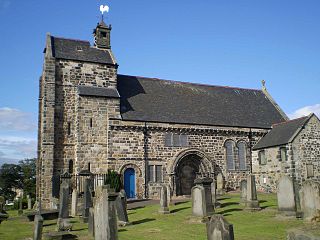
Kirkliston is a small town and parish to the west of Edinburgh, Scotland, historically within the county of West Lothian. It lies on high ground immediately north of a northward loop of the Almond, on the old road between Edinburgh and Linlithgow, having a crossroads with the road from Newbridge to Queensferry and beyond to Fife. The B800 is variously named Path Brae, High Street, Station Road, and Queensferry Road as it passes through the town. The B9080 is named Main Street and Stirling Road as it passes through.

St Andrew's and St George's West Church serves Edinburgh's New Town, in Scotland. It is a congregation of the Church of Scotland. The parish today constitutes the whole of the First New Town of Edinburgh and a small part of the early-19th-century Second New Town of Edinburgh. The church building was completed in 1784, and is now protected as a category A listed building.

St Mary's Cathedral or the Cathedral Church of Saint Mary the Virgin is a cathedral of the Scottish Episcopal Church in the West End of Edinburgh, Scotland. It was built in the late 19th century in the West End of Edinburgh's New Town. The cathedral is the see of the Bishop of Edinburgh, one of seven bishops within the Episcopal Church, which is part of the Anglican Communion. Designed in a Gothic style by (Sir) George Gilbert Scott, the cathedral is now protected as a category A listed building. and part of the Old Town and New Town of Edinburgh World Heritage Site. Reaching 90 metres (295 ft), its spire makes the building the tallest in the Edinburgh urban area.

Linlithgow is a town in West Lothian, Scotland. It was historically West Lothian's county town, reflected in the county's historical name of Linlithgowshire. An ancient town, it lies in the Central Belt on an historic route between Edinburgh and Falkirk beside Linlithgow Loch. The town is situated approximately 20 miles west of Edinburgh.
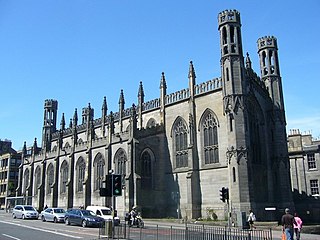
St Paul's and St George's Church is an evangelical church of the Scottish Episcopal Church in central Edinburgh, Scotland. It is located on the corner of Broughton Street and York Place in the east end of Edinburgh's New Town, and is protected as a category A listed building.
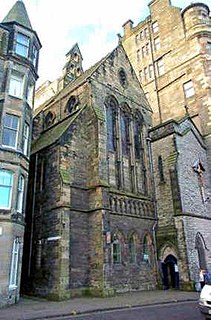
Old Saint Paul's is an historic church of the Scottish Episcopal Church in the heart of Edinburgh's Old Town in Scotland. It is one of the original congregations of the Scottish Episcopal Church, part of the Anglican Communion, which evolved with the adoption of Presbyterian governance by the established Church of Scotland.

St. Paul's Protestant Episcopal Church, more commonly called Old St. Paul's Church today, is a historic Episcopal church located at 233 North Charles Street at the southeast corner with East Saratoga Street, in Baltimore, Maryland, near "Cathedral Hill" on the northern edge of the downtown central business district to the south and the Mount Vernon-Belevedere cultural/historic neighborhood to the north. It was founded in 1692 as the parish church for the "Patapsco Parish", one of the "original 30 parishes" of the old Church of England in colonial Maryland.

The Queen's Hall is a 900-capacity music venue, situated on Clerk Street in Edinburgh, Scotland. Originally built in 1823 as Hope Park Chapel, it was converted to its current role in 1979 and was formally opened by Queen Elizabeth II on 6 July 1979.
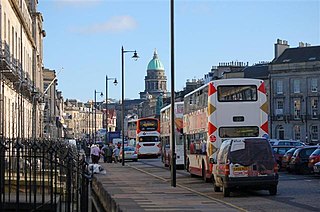
The West End is an affluent district of Edinburgh, Scotland, which along with The New and Old Towns forms central Edinburgh, and Edinburgh's UNESCO World Heritage Site. The West End boasts several of the city's hotels, restaurants, independent shops, offices and arts venues, including the Edinburgh Filmhouse, Edinburgh International Conference Centre and the Caledonian Hotel. The area also hosts art festivals and crafts fairs.
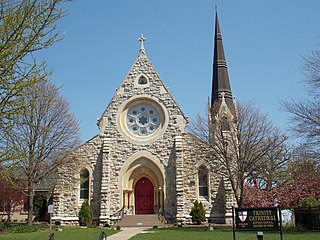
Trinity Episcopal Cathedral, formerly known as Grace Cathedral, is the historic cathedral in the Diocese of Iowa. The cathedral is located on the bluff overlooking Downtown Davenport, Iowa, United States. Completed in 1873, Trinity is one of the oldest cathedrals in the Episcopal Church in the United States. It was individually listed on the National Register of Historic Places in 1974. In 1983 the cathedral was included as a contributing property in the College Square Historic District, which is also listed on the National Register.

St Michael's Roman Catholic Church, Linlithgow is situated in the historic town of Linlithgow. The present church is situated at the East end of the town near the Low Port. It is located beside the banks of Linlithgow loch and close to the old palace where Mary Queen of Scots was born. Next to the palace is the Parish Church of St Michael's the original seat of the Catholic Church prior to the reformation. This brief history chronicles the Catholic Church in Linlithgow from inception to the present day.

St. Paul's Episcopal Cathedral, is located in downtown Des Moines, Iowa, United States. It is the cathedral church of the Episcopal Diocese of Iowa. The building was listed on the National Register of Historic Places as St. Paul's Episcopal Church.

St. Andrew's Episcopal Church is located at North Main and Madison avenues in Albany, New York, United States. It is a complex of three buildings, centered on the church itself, a stone structure designed by architect Norman Sturgis in the Late Gothic Revival architectural style and built in 1930. In 2005 it was listed on the National Register of Historic Places.
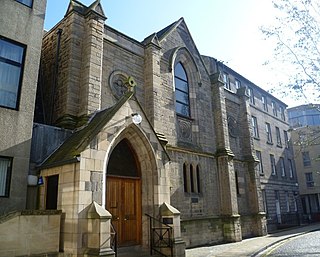
The King Khalid Building is an event space in the Southside, Edinburgh, Scotland, owned and operated by the Royal College of Surgeons of Edinburgh. The building was constructed Roxburgh Free Church in 1847 and converted to its current use in 1982.

St Patrick's Church is a Roman Catholic Parish church in the Cowgate part of Old Town, Edinburgh, Scotland. It was built from 1771 to 1774, and became a Catholic church in 1856. The facade of the church was designed by Reginald Fairlie in 1929. It is situated between South Gray's Close and St Mary's Street north of Cowgate and south of the Royal Mile. It is a category B listed building.

The King's Hall is a church in Newington, Edinburgh, Scotland. Constructed as Newington Free Church in 1843, it is now used by Community Church Edinburgh: an independent evangelical congregation.
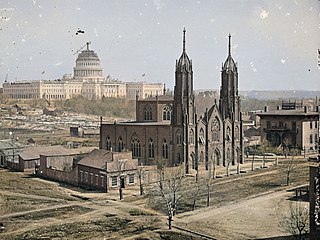
Trinity Episcopal Church was an Episcopal church that once stood on the northeast corner of 3rd and C Streets NW in the Judiciary Square neighborhood of Washington, D.C. Founded in 1827, the parish was home to prominent attendees including President John Quincy Adams, Senator Daniel Webster, and Francis Scott Key, who served as the church's senior warden. The first church building was located on 5th Street NW, across the street from District of Columbia City Hall, in what was then a fashionable area of the city. Due to continued growth, the parish needed additional space and began plans to build a new sanctuary. With financial assistance from William Wilson Corcoran, the parish bought a nearby lot and a cornerstone was laid in 1850.





















